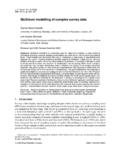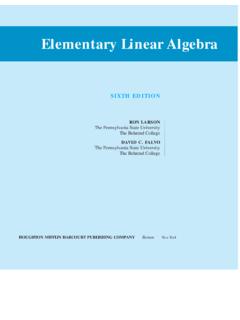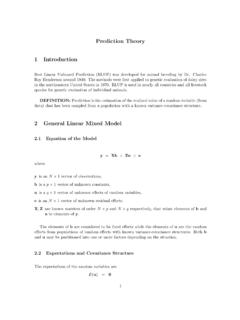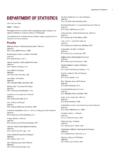Transcription of Multilevel structural equation modeling - GLLAMM
1 Multilevel structural equation modeling Sophia Rabe-Hesketh Graduate School of Education & Graduate Group in Biostatistics, University of California, Berkeley & Institute of Education, University of London Anders Skrondal Department of Statistics & Methodology Institute, London School of Economics &. Division of Epidemiology, Norwegian Institute of Public Health, Oslo Xiaohui Zheng Graduate School of Education, University of California, Berkeley Abstract In conventional structural equation models, all latent variables and indicators vary between units (typically subjects) and are assumed to be independent across units. The latter assumption is violated in Multilevel settings where units are nested in clusters, leading to within-cluster de- pendence.
2 Different approaches to extending structural equation models for such Multilevel settings are examined. The most common approach is to formulate separate within-cluster and between-cluster models. An advantage of this set-up is that it allows software for conventional struc- tural equation models to be tricked' into estimating the model. However, the standard implementation of this approach does not permit cross-level paths from latent or observed variables at a higher level to latent or ob- served variables at a lower level, and does not allow for indicators varying at higher levels. A Multilevel regression (or path) model formulation is therefore suggested in which some of the response variables and some of the explanatory variables at the different levels are latent and measured by multiple indicators.
3 The Generalized Linear Latent and Mixed Model- ing ( GLLAMM ) framework allows such models to be specified by simply letting the usual model for the structural part of a structural equation model include latent and observed variables varying at different levels. Models of this kind are applied to the sample of the Program for International Student Assessment (PISA) 2000 to investigate the relation- ship between the school-level latent variable teacher excellence' and the student-level latent variable reading ability', each measured by multiple ordinal indicators. Keywords: Multilevel structural equation models, generalized linear mixed models, latent variables, random effects, hierarchical models, item response theory, factor models, adaptive quadrature, empirical Bayes, GLLAMM .
4 To appear in: S. Y. Lee (Ed.). Handbook on structural structural equation Models. Amsterdam: Elsevier. 1. 1 introduction The popularity of Multilevel modeling and structural equation modeling (SEM). is a striking feature of quantitative research in the medical, behavioral and so- cial sciences. Although developed separately and for different purposes, SEM. and Multilevel modeling have important communalities since both approaches include latent variables or random effects to induce, and therefore explain, cor- relations among responses. Multilevel regression models are used when the data structure is hierarchical with elementary units at level 1 nested in clusters at level 2, which in turn may be nested in (super)clusters at level 3, and so on.
5 The latent variables, or ran- dom effects, are interpreted as unobserved heterogeneity at the different levels which induce dependence among all lower-level units belonging to a higher-level unit. Random intercepts represent heterogeneity between clusters in the over- all response and random coefficients represent heterogeneity in the relationship between the response and explanatory variables. structural equation models are used when the variables of interest cannot be measured perfectly. Instead, there are either sets of items reflecting a hypotheti- cal construct ( depression) or fallible measurements of a variable ( calory intake) using different instruments.
6 The latent variables, or factors, are inter- preted as constructs, traits or true' variables, underlying the measured items and inducing dependence among them. The measurement model is sometimes of interest in its own right, but relations among the factors or between factors and observed variables (the structural part of the model) are often the focus of investigation. Importantly, Multilevel structural equation modeling , a synthesis of Multilevel and structural equation modeling , is required for valid statistical inference when the units of observation form a hierarchy of nested clusters and some variables of interest are measured by a set of items or fallible instruments.
7 Multilevel structural equation modeling also enables researchers to investigate exciting research questions which could not otherwise be validly addressed. For instance, in this chapter we will consider an important question in education: does student ability (a student-level latent trait) depend on teacher excellence (a school-level latent trait)? Multilevel structural equation models could be specified using either mul- tilevel regression models or structural equation models as the vantage point. An advantage of using the Multilevel regression approach taken here is that the data need not be balanced and missing data are easily accommodated.
8 2 Response Types Continuous responses structural equation models were originally developed for continuous responses. In this case the response model' or measurement model' for subject j, relat- ing the observed response vector yj of manifest variables or indicators to the latent variables j , the observed covariates xj , and the error terms j (usually representing unique factors'), has the general form y j = j + j , j N(0, ). 2. Here j are functions of j and xj (see Section 3) and is the covariance matrix of j , usually specified as diagonal. Non-continuous responses Latent response formulation When the responses are dichotomous or ordinal, the same model as above can be specified for latent continuous responses y j underlying the observed responses yj.
9 A threshold model links the observed response for the ith indicator to the corresponding latent response, . yij = s if is < yij i,s+1 , s = 0, .. , S 1, i0 = , iS = . The threshold parameters is (apart from i0 and iS ) can all be estimated if the mean and variance of y j are fixed. Alternatively, two thresholds can be fixed (typically i1 = 0 and i2 = 1) for each response variable to identify the means and variances of y j . Grouped or interval censored continuous responses can be modeled in the same way by constraining the threshold parameters to the limits of the censoring intervals. By allowing unit-specific right-censoring, this approach can be used for discrete time durations.
10 An advantage of the latent response formulation is that conventional mod- els can be specified for the underlying continuous responses. By changing the distribution of j , the latent response formulation can also be used to specify logit models. Models for comparative responses such as rankings or pairwise comparisons can be formulated in terms of latent responses conceptualized as utilities or utility differences ( , Skrondal and Rabe-Hesketh, 2003). Generalized linear model formulation Unfortunately, the latent response formulation cannot be used to specify Poisson models for counts. Instead, a generalized linear model formulation is typically used where the conditional expectation of the response yij for indicator i given xj and j is linked' to the linear predictor ij via a link function g( ), g(E[yij |xj , j ]) = ij.










